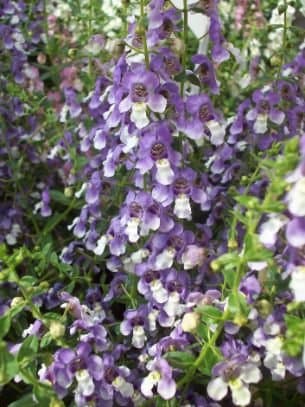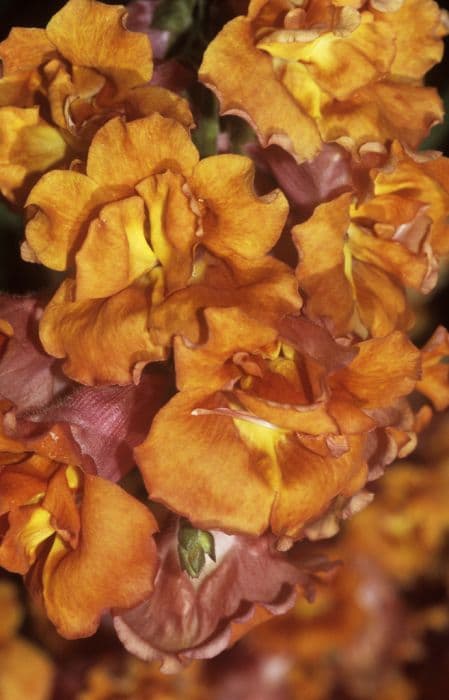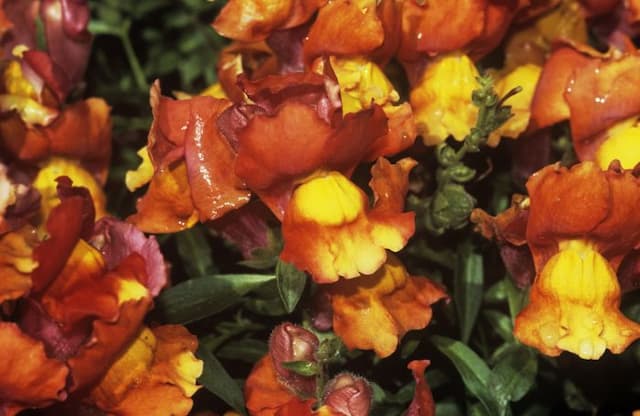Strawberry Foxglove Digitalis × mertonensis

ABOUT
Commonly known as the strawberry foxglove, the plant displays eye-catching flowers that are tubular in shape and come in a blend of pink and muted strawberry hues. These drooping bell-like blossoms are densely arranged around a central spike, giving the plant a lofty appearance with a majestic display of color that can attract garden visitors such as bees and hummingbirds. Its foliage consists of coarse textured, large, ovate leaves with a slightly furry texture and a gray-green shade that provides an attractive base for the towering blooms. The leaves form a rosette at the base of the flower spikes. This striking plant is a perennial, ensuring a showy return each year under the right conditions, making it a popular choice among gardeners looking to add a touch of natural elegance to their garden spaces without the mention of the specifics of its size.
About this plant
 Names
NamesFamily
Plantaginaceae.
Synonyms
Strawberry Foxglove, Summer King.
Common names
Digitalis × mertonensis
 Toxicity
ToxicityTo humans
Digitalis × mertonensis, commonly known as Strawberry Foxglove, is toxic to humans. This plant contains cardiac glycosides, particularly digoxin and digitoxin, which can be poisonous if ingested. These compounds affect the heart and can cause symptoms such as nausea, vomiting, diarrhea, dizziness, changes in heart rhythm, and in severe cases, cardiac failure. If a person ingests any part of the Strawberry Foxglove, they should seek medical attention immediately due to the risk of serious heart complications or death.
To pets
Strawberry Foxglove is toxic to pets as well as humans. Like with human toxicity, the cardiac glycosides present in the plant, such as digoxin and digitoxin, can cause severe symptoms if ingested by animals. Symptoms of poisoning in pets may include vomiting, diarrhea, weakness, cardiac abnormalities, and possibly seizures. Ingestion of even small amounts can be life-threatening, and you should seek veterinary care immediately if you suspect your pet has eaten any part of this plant.
 Characteristics
CharacteristicsLife cycle
Perennials
Foliage type
Semi-deciduous
Color of leaves
Green
Flower color
Pink
Height
2-3 feet [60-90 cm]
Spread
1-2 feet [30-60 cm]
Plant type
Herb
Hardiness zones
5
Native area
Europe
Benefits
 General Benefits
General Benefits- Attracts Pollinators: Digitalis × mertonensis, commonly known as Strawberry Foxglove, attracts bees and other pollinating insects to the garden, which is essential for plant reproduction and biodiversity.
- Aesthetic Appeal: With its striking spikes of pink flowers, Strawberry Foxglove adds height and visual interest to borders and garden landscapes.
- Wildlife Habitat: Offers shelter and food resources for various forms of wildlife, including insects and sometimes small birds.
- Drought Tolerance: Once established, Strawberry Foxglove can tolerate periods of dry weather, making it suitable for gardens in drier climates.
- Low Maintenance: Requires minimal care once it has settled into the garden, making it an ideal choice for gardeners seeking low-maintenance plantings.
- Perennial Growth: As a perennial, Strawberry Foxglove will return year after year, contributing to a stable garden structure and reducing the need for annual replanting.
 Medical Properties
Medical PropertiesThis plant is not used for medical purposes.
 Air-purifying Qualities
Air-purifying QualitiesThis plant is not specifically known for air purifying qualities.
 Other Uses
Other Uses- Dye Production: The flowers of the Strawberry Foxglove can be used to create natural dyes for fabrics, yielding various shades of color depending on the mordant used.
- Garden Photography: The plant's tall spikes and vibrant flowers make it a popular subject for photographers specializing in garden and plant photography.
- Aesthetic Medicine: The visual appeal of Strawberry Foxglove is leveraged in therapeutic gardens designed to improve well-being through interaction with beautiful and serene plant settings.
- Art Subjects: The distinctive flowers serve as inspiration for artists, featuring in watercolor paintings, botanical illustrations, and garden-themed art pieces.
- Educational Tool: Strawberry Foxglove can be used in educational settings to teach students about plant biology, hybridization, and horticulture.
- Garden Design: Used as a 'vertical accent' in landscape design, the tall flower spikes can create depth and structure within a garden layout.
- Ecosystem Support: Although not a major source of nectar, they can provide some support for pollinators like bees and hummingbirds in the garden.
- Horticultural Therapy: The process of growing and caring for Strawberry Foxglove can be used as a form of horticultural therapy to improve mental health and cognitive function.
- Folklore and Mythology: The plant may be used in storytelling or theming of gardens based on its association with historic folklore and legends.
- Seasonal Displays: Due to their showy blooms, Strawberry Foxgloves are often featured in temporary seasonal floral arrangements and displays in public gardens and parks.
Interesting Facts
 Feng Shui
Feng ShuiThe Strawberry Foxglove is not used in Feng Shui practice.
 Zodiac Sign Compitability
Zodiac Sign CompitabilityThe Strawberry Foxglove is not used in astrology practice.
 Plant Symbolism
Plant Symbolism- Healing: Digitalis x mertonensis, commonly known as Strawberry Foxglove, is used medicinally to produce digitalin, which treats heart conditions. Therefore, it symbolizes healing powers.
- Bewilderment: The plant's beautiful but toxic nature can signify deception or illusion, leading to confusion or bewilderment.
- Protection: In folklore, Foxgloves were considered to protect homes from evil influences, so they may symbolize a safe haven or warding off negativity.
 Water
WaterThe Strawberry Foxglove should be watered moderately, ensuring that the soil is kept consistently moist but not waterlogged. During the active growing season in spring and summer, it may need water once or twice a week, depending on the climate and weather conditions. Use about 1 gallon of water per plant each time you water, being careful not to wet the foliage to avoid fungal diseases. In winter, reduce watering to whenever the soil appears dry to the touch, approximately every 2-3 weeks. Always check the soil moisture level before watering to avoid over-watering.
 Light
LightStrawberry Foxglove thrives in partial shade to full sun. The ideal spot for this plant is where it can receive morning sunlight and be protected from the intense heat of the afternoon sun. Ensure it gets at least 4 hours of direct sunlight daily for optimum growth, but if you're in a hotter climate, aim for a location that offers some afternoon shade to prevent the plant from getting scorched.
 Temperature
TemperatureStrawberry Foxglove prefers a temperate climate and fares best in temperatures ranging from 60°F to 75°F. It can tolerate temperatures down to 30°F, but frost may damage the foliage. It's important to protect the plant from extreme cold, and it usually won't survive if the temperature drops below 20°F. Ideal growing conditions include cool nights and warm days.
 Pruning
PruningPruning Strawberry Foxglove is essential for maintaining its appearance and health. Deadheading spent flowers promotes more blooms and prevents the plant from self-seeding too aggressively. After the main flowering spike has faded, cut it back to encourage side shoots and a second flush of flowers. Pruning should be done as needed throughout the blooming period, typically from late spring to late summer.
 Cleaning
CleaningAs needed
 Soil
SoilThe Strawberry Foxglove, Digitalis × mertonensis, thrives best in moist, well-drained soil with rich organic matter. A suitable soil mix can be made by combining two parts loam, one part peat or leaf mold, and one part sand or perlite to ensure good drainage. The ideal soil pH for Strawberry Foxglove should range between 6.0 and 7.0. Adding a layer of mulch can help retain moisture and keep the root system cool.
 Repotting
RepottingStrawberry Foxglove, Digitalis × mertonensis, does not frequently require repotting as it is a perennial, and in a garden setting, it can thrive for several years in the same spot. However, if grown in containers, repotting every 2 to 3 years or when it outgrows its current pot may be necessary.
 Humidity & Misting
Humidity & MistingStrawberry Foxglove, Digitalis × mertonensis, performs well in average garden humidity levels. It does not require any special humidity conditions, making it adaptable to the humidity found in most outdoor garden environments.
 Suitable locations
Suitable locationsIndoor
For Strawberry Foxglove, provide bright indirect light and keep soil consistently moist.
Outdoor
Plant in partial shade, moist soil; mulch to maintain moisture.
Hardiness zone
5-8 USDA
 Life cycle
Life cycleDigitalis × mertonensis, commonly known as the Strawberry Foxglove, starts its life cycle as a seed, sown in late spring to early summer, where it germinates in cool, moist soil. After seedlings emerge and develop true leaves, the plant goes through a vegetative stage, growing a rosette of downy, green leaves. In its second year, the Strawberry Foxglove enters the flowering stage, sending up a tall spike adorned with tubular, pink flowers that are attractive to bees and other pollinators. Following pollination, the flowers develop into seed capsules that release seeds when mature, completing the reproductive cycle. As a perennial hybrid, the plant may continue to grow and produce flowers for several years, although it often behaves more like a biennial, potentially dying after the second year. Any seeds produced can create new plants, continuing the cycle, while the parent plant may also spread vegetatively through basal offshoots.
 Propogation
PropogationPropogation time
Spring to early summer
The Strawberry Foxglove, Digitalis × mertonensis, is typically propagated by seed. To propagate by seed, the best time is usually in late spring or early summer after the threat of frost has passed. Sow the seeds thinly in a well-drained soil mix, covering them with a thin layer of soil or vermiculite. Keep the soil moist but not waterlogged, and place the seed tray in a warm, bright area without direct sunlight. Germination can take from 2 to 4 weeks. Once the seedlings are large enough to handle, they can be transplanted into individual pots and grown on until they are ready to be planted out in the garden after they have developed a strong root system.









